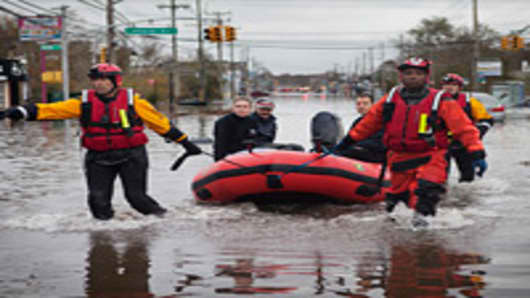Early estimates of the economic impact of Hurricane Sandy put the total loss between $30 billion and $50 billion, making it one of the costliest storms in U.S. history.
But forecasters acknowledge that their estimates are highly preliminary and the financial toll could rise as the extent of damage from the historic storm becomes more apparent.
The unique nature of the hurricane — the destructive storm surge and the vast and densely populated region affected, accounting for about a quarter of the nation's economic activity — raises questions about whether the normal models used to gauge losses will fully capture the costs of Sandy.
Two principal factors account for the losses: lost economic business activity and insured and uninsured property losses. These will be somewhat offset by economic activity from the cleanup and rebuilding, but there is a substantial debate about just how much of an offset this provides.
(Read more: Storm Recovery Could Take Weeks as Millions Struggle)
While some analysts have suggested there could even be a net positive impact, when all the spending is added up, economic research on the impact of hurricanes suggests that is not the case.
"It would be naïve to put forward the view that a hurricane is in some sense a stimulus for the economy," wrote IHS Global Insight U.S. Economists Gregory Daco and Nigel Gault. "There's no guarantee that reconstruction activity will be extra activity, on top of what would otherwise have occurred, rather than a substitute for that activity."
Mark Zandi, of Moodys.com, estimates that two days' worth of business activity in the region could be lost, valued at around $20 billion. Meanwhile, catastrophe modeling firm AIR Worldwide has put the potential insured losses at $7 to $15 billion. These losses are normally about half of total losses since some are either uninsured or covered by the government.
In fact, in this case, since so much damage was the result of storm surges, the percentage of uninsured claims could be significantly higher. The uninsured category also would include flood damage to airports and the New York City subway system, which will make claims for the bulk of its losses to the Federal Emergency Management Agency.
(Read more: Price Gouging Hits New Level)
But using the general rule of thumb, total insured and uninsured losses could total $14 to $30 billion. Adding that to the lost business activity would make this a $34 to $50 billion event, which is almost what IHS Global Insights has calculated.
By contrast, the two costliest hurricanes in U.S. history to date were Katrina, with estimated losses of $146 billion, and Andrew, with loses estimated at $44 billion.
But there are offsets and Zandi and other economists note that there will be considerable rebuilding that will accompany the storm. Because the storm hit early in the quarter, Zandi points out that if $20 billion is spent cleaning up and rebuilding, the actual measured impact on gross domestic product could be zero.
IHS is doubtful. They note that the rebuilding often takes the place of investment elsewhere and often not everything is rebuilt.
"The effect on growth for the fourth quarter will not be catastrophic but might still be noticeable, especially in an economy with little momentum anyway," IHS wrote.
The debate begs the question of whether such natural disasters can ultimately stimulate an economy. Eric Strobl, of the Ecole Polytechnique in Paris, who has studied the impact of hurricanes for more than a decade, found that hurricanes at the local level are usually negative for growth.
Looking at the impact of storms from 1970 through 2005, he found they usually take off about half a percentage point from local county-level growth, a big number considering that average growth at that level is only 1.68 percent. Strobl found hurricane effects generally negative at the state level and negligible at the country level.
What about the infusion of money from the federal government and insurance companies from outside the affected area? Strobl suggests that has costs as well.
"Resources used to replace destroyed capital cannot be used elsewhere and hence growth may even at the level of the state be less in the much longer run,'' he wrote in his paper. "Similarly, funds used to reimburse insurance claims and provide disaster relief assistance, while perhaps not coming directly from the affected state will have to be sourced somewhere, and thus sacrificed from other potentially more nationally growth enhancing uses."
In other words, destroying plant, property and equipment is not a positive long-run growth strategy. Where an economy can benefit, however, is in rebuilding destroyed assets better than they were.
If, for example, New Jersey were to rebuild its coastline with greater storm surge protection than previously existed, and if the housing stock is replaced with better homes that are sturdier, than on net the nation's capital stock will be improved.
Much will be determined in the coming days and weeks, economists say. The ultimate price tag could rest on how quickly power and transportation are restored and how quickly funds are allocated to rebuilding.





